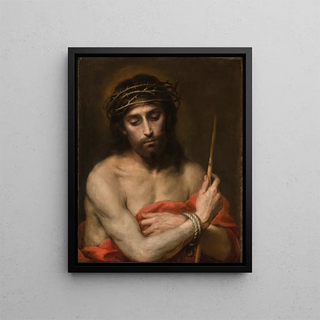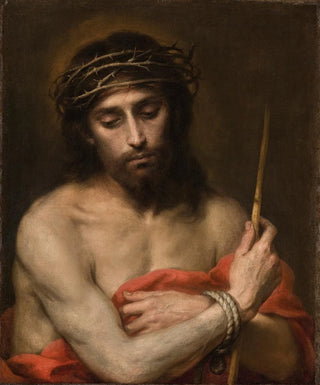Art print | Voici l'homme - Bartolomé Esteban Murillo


View from behind

Frame (optional)
Here is the man - Bartolomé Esteban Murillo – Captivating introduction
In the vast panorama of art history, some works manage to transcend time and capture the essence of humanity. "Here is the man" by Bartolomé Esteban Murillo perfectly fits into this category. This painting, imbued with rare emotional depth, invites us to contemplate the human condition through the prism of spirituality and sensitivity. Murillo, master of Spanish baroque, succeeds here in combining technical virtuosity with psychological depth, offering viewers a visual experience as rich as it is unsettling. The art print of this masterpiece allows us to revisit this iconic work, explore its subtleties, and immerse ourselves in the artistic universe of its creator.
Style and uniqueness of the work
The work "Here is the man" stands out for its baroque style, characterized by bold use of light and shadow, a technique known as chiaroscuro. Murillo, a true virtuoso, plays with contrasts to emphasize the expressions of the characters, thus creating an emotional dialogue with the viewer. The faces, imbued with gentleness and melancholy, seem to tell a story, that of a man confronting his own existence. The drapery, carefully rendered, adds a tactile dimension to the painting, while the warm, earthy color palette evokes an atmosphere that is both intimate and universal. This work does not merely depict a scene; it invites reflection on human nature, on inner struggles and spiritual aspirations that unite us all.
The artist and his influence
Bartolomé Esteban Murillo, born in Seville in the 17th century, is one of the major figures of Spanish painting. His artistic journey is marked by a passion for depicting everyday life and religious themes, but it is his ability to capture the beauty of human emotions that sets him apart. Influenced by the great masters of the Renaissance and baroque, Murillo developed a style that is uniquely his own, blending realism and idealization. His work had a significant impact on his contemporaries and on subsequent generations, inspiring artists across Europe

Matte finish

View from behind

Frame (optional)
Here is the man - Bartolomé Esteban Murillo – Captivating introduction
In the vast panorama of art history, some works manage to transcend time and capture the essence of humanity. "Here is the man" by Bartolomé Esteban Murillo perfectly fits into this category. This painting, imbued with rare emotional depth, invites us to contemplate the human condition through the prism of spirituality and sensitivity. Murillo, master of Spanish baroque, succeeds here in combining technical virtuosity with psychological depth, offering viewers a visual experience as rich as it is unsettling. The art print of this masterpiece allows us to revisit this iconic work, explore its subtleties, and immerse ourselves in the artistic universe of its creator.
Style and uniqueness of the work
The work "Here is the man" stands out for its baroque style, characterized by bold use of light and shadow, a technique known as chiaroscuro. Murillo, a true virtuoso, plays with contrasts to emphasize the expressions of the characters, thus creating an emotional dialogue with the viewer. The faces, imbued with gentleness and melancholy, seem to tell a story, that of a man confronting his own existence. The drapery, carefully rendered, adds a tactile dimension to the painting, while the warm, earthy color palette evokes an atmosphere that is both intimate and universal. This work does not merely depict a scene; it invites reflection on human nature, on inner struggles and spiritual aspirations that unite us all.
The artist and his influence
Bartolomé Esteban Murillo, born in Seville in the 17th century, is one of the major figures of Spanish painting. His artistic journey is marked by a passion for depicting everyday life and religious themes, but it is his ability to capture the beauty of human emotions that sets him apart. Influenced by the great masters of the Renaissance and baroque, Murillo developed a style that is uniquely his own, blending realism and idealization. His work had a significant impact on his contemporaries and on subsequent generations, inspiring artists across Europe






